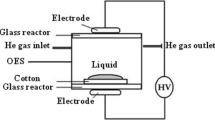Abstract
The hydrophobic cuticle of the cotton fiber has formed a natural barrier for pectinase to catalyze its substrates (pectins beneath the cuticle), thus resulting in an insufficient scouring for cotton. Two plasma-based treatments, dielectric barrier discharge (DBD) at atmospheric pressure and cold oxygen plasma at low pressure in a vacuum system, were used as the pretreatments prior to cotton bioscouring, aiming at increasing the accessibility of pectinases to the pectic substances on the cotton fiber. The effects of different processing parameters of DBD and oxygen plasmas on the wettability, whiteness and burst strength of pectinase-scoured cotton were determined and compared. Although both of the pretreatments could enhance cotton bioscouring, DBD might be more suitable for current bioscouring due to its continuous processing mode and lower requirements to the equipment.





Similar content being viewed by others
References
Canal JM, Navarro A, Calafell M et al (2004) Color Technol 120:311
Wang Q, Fan XR, Hua ZZ et al (2007) Biocatal Biotransfor 25:9
Abdel-Halim ES, Fahmy HM, Fouda MMG (2008) Carbohyd Polym 74:707
Presa P, Tavcer PF (2008) Color Technol 124:36
Etters JN, Husain PA, Lange NK (1999) Textile Asia 30:83
Csiszar E, Losonczi A, Szakacs G et al (2001) J Biotechnol 89:271
Li Y, Hardin IR (1998) Textile Chem Color Am Dyest Rep 30:23
Traore MK, Buschle-Diller G (2000) Textile Chem Color Am Dyest Rep 32:40
Sangwatanaroj U, Choonukulpong K, Ueda M (2003) AATCC Rev 3:17
Choe EK, Nam CW, Kook SR et al (2004) Biocatal Biotransfor 22:375
Ibrahim NA, El-Hossamy M, Morsy MS et al (2004) J Appl Polym Sci 93:1825
Wang Q, Fan XR, Gao WD et al (2006) Carbohyd Res 341:2170
Hartzell MM, Hsieh YL (1998) Text Res J 68:233
Wang Q, Fan X, Yuan J et al (2008) Eng Life Sci 8:339
Takagishi T, Yamamoto R, Kikuyama K et al (2001) AATCC Rev 1:32
Sawada K, Ueda M (2001) J Biotechnol 89:263
Sawada K, Tokino S, Ueda M et al (1998) JSDC 114:333
Yachmenev VG, Bertoniere NR, Blanchard EJ (2001) Text Res J 71:527
Yachmenev VG, Bertoniere NR, Blanchard EJ (2002) J Chem Technol Biot 77:559
Yachmenev VG, Blanchard EJ, Lambert AH (2004) Ultrasonics 42:87
Luo S, van Ooij WJ (2002) J Adhes Sci Technol 16:1715
Kang JY, Sarmadi M (2004) AATCC Rev 4:28
Morent R, De Geyter N, Verschuren J (2008) Surf Coat Technol 202:3427
Hossain MM, Herrmann AS, Hegemann D (2007) Plasma Process Polym 4:135
Wilken R, Holländer A, Behnisch J (1999) Surf Coat Technol 991:116
Xu WL, Liu X (2003) Eur Polym J 39:199
Kogelschatz U (2003) Plasma Chem Plasma Process 23:1
Seiji K, Shigeo O, Mitsuji A et al (2006) Japanese Patent No. 2006132039
Zhang JH, Li Y, Liu H et al (2005) Chin J Appl Environ Biol 11:354 (in Chinese)
Wang Q, Fan XR, Hua ZZ et al (2007) Biochem Eng J 34:107
Acknowledgments
This work was financially supported by the National High Technology Research and Development Program of China (2009AA02Z204).
Author information
Authors and Affiliations
Corresponding author
Rights and permissions
About this article
Cite this article
Wang, Q., Fan, XR., Cui, L. et al. Plasma-Aided Cotton Bioscouring: Dielectric Barrier Discharge Versus Low-Pressure Oxygen Plasma. Plasma Chem Plasma Process 29, 399–409 (2009). https://doi.org/10.1007/s11090-009-9187-x
Received:
Revised:
Accepted:
Published:
Issue Date:
DOI: https://doi.org/10.1007/s11090-009-9187-x




